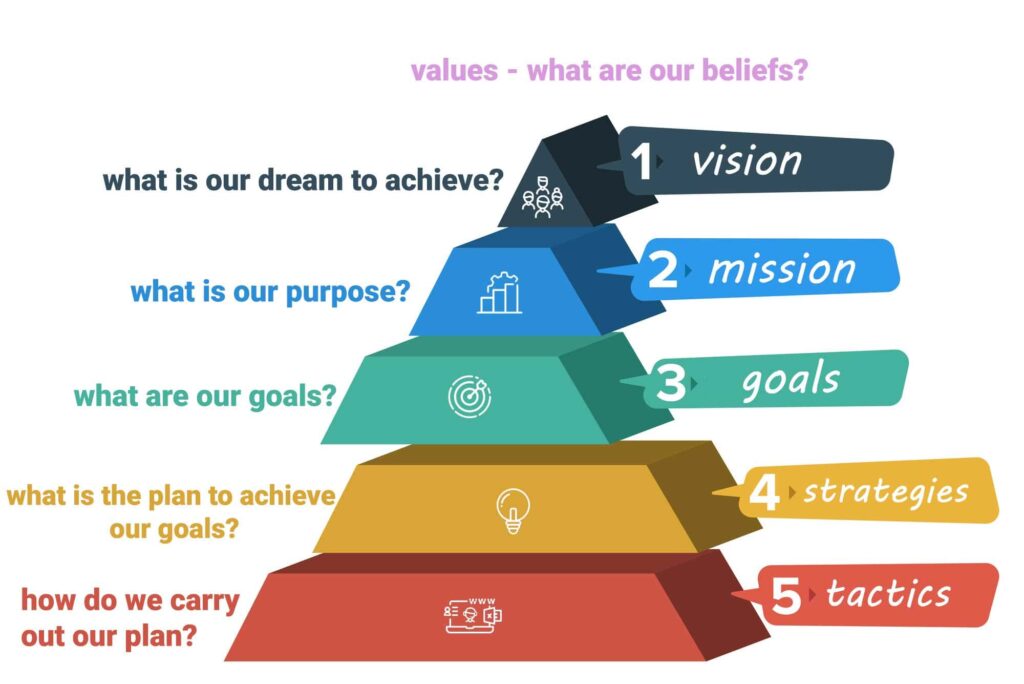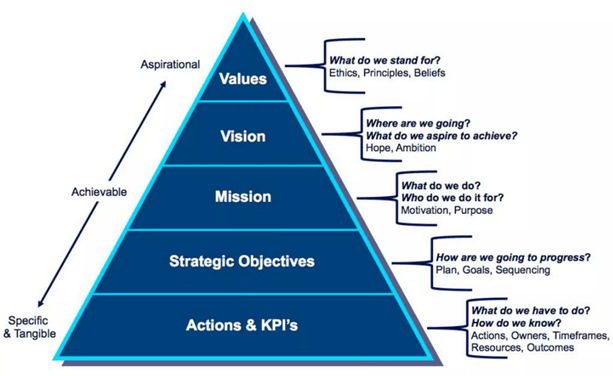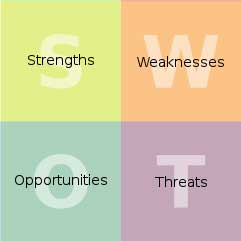
How to write a business strategic plan
This article is a step-by-step guide to writing a business strategic plan using the strategy pyramid.
The business strategy and strategy pyramid are explained in the introduction section, followed by the 7 key elements to create the business strategic plan as follows:
What is a business strategy?
A business strategy is all the plans, decisions and actions that a business takes to achieve its vision.
A business may set goals to reach some targets of success and plan to employee a number of people and spend a budget. But what is it that the business needs to do to achieve its goals? The ‘how’ to achieve the goals is the strategy.
To create a strategy it is necessary to understand the direction of the business, where it is going and to decide how to get there.
Importance of a business strategy
Everyone and everything aligns to the direction set by the values, vision and mission, giving clear goals that make it easier to define strategies and tactics to implement these strategies and reach the goals.
With a clear business strategy both employees and customers understand the company, the purpose of the company, and the direction of the company.

An example of a business strategy pyramid model.
Source: Strategy Pyramid – 5 Levels by Jacob Thoft-Christensen at https://www.slideshare.net/jacobthoft/strategy-pyramid
Business strategy pyramid explained
The business strategy pyramid is a tool designed to help you develop a comprehensive and efficient plan that can take your business to the next level.
Each level represents a stage or key element in the process of developing your business strategic plan.
Use the pyramid from top to bottom to focus on the essential, overall guide to what you want to do, then the analysis and planning of how you are going to achieve your overall goals.
As you get to the lower parts of the pyramid there are more details, so, for example, you may have several tactics to implement one strategy.
There different version of the business strategy pyramid, although the concept is the same. We have seen it called a business strategy triangle.
Use the pyramid to help you define your business strategic plan.
Use the strategy pyramid implementation
Building an effective business strategy requires a well-thought-out approach.
Start by establishing your strategic goals. If you don’t have clear objectives, it’s impossible to reach success. Think about what you want to achieve and create a timeline for completing these goals.
Set measurable targets and prioritize them in order of importance for the best results. Make sure that all of your goals are achievable and realistic.
In business you will have many choices and face many decisions. To use your resources wisely it is advisable to focus how to use these resources over a long period of time – this is your business strategic plan.
Focus on what is important and give what you do a sense of purpose – a reason why you do what you do.
From this plan you can focus and not get sidetracked into either wasting your resources on less important things, or, have different people, actions or events move away from your chosen direction.
How to write a business strategy
Once the initial elements of the business strategy have been realized to determine the company direction, planning can occur.
From our values we can determine where are we going with our vision and mission.
To know where we are now we use both internal and external analysis. This is often achieved with a swot analysis looking at strengths, weaknesses, successes and failures.
Our position as a company is determined by internal forces such as our resources, but also external factors such as our market position and business environment.
Our analysis gives incite into potential beneficial approaches and factors to consider that ultimately lead us to create a plan.
We need to determine how to carry out our plan to reach our goals, what are the risks, what predictions can we can make, both good and bad.
We carry out our plans led by our strategic priorities and tactics. We measure our performance to ensure we are heading in the right direction and meeting our goals.
The 7 key elements of a business strategy
The 7 basic elements of a strategic plan are the:
- core values
- vision
- mission
- SWOT & TOWS analysis
- goals
- strategies (objectives)
- tactics
Alternatives to these elements include the additional final stages of your action plans and key performance indicators (KPI).
PREVIOUS BUSINESS INNOVATION ACTIVITIES
Visit the web page hub : – innovative entrepreneurship for students
What are your core values?
Core values are your fundamental beliefs and determine the difference between right and wrong.
All employees need to be aligned with the same understanding of what the company is about, where it is going, and how to conduct business.
Consider your own beliefs and what is important to you. As the head of a company what words describe you and your actions? The positive characteristics that you want your company to represent you.
Examples of core values that we would associate with alps academy include: caring, honest, trustworthy, reliable, professional, competent, responsible, respectful, hard working and integrity.
PREVIOUS BUSINESS INNOVATION ACTIVITIES
Visit the web page hub : – core values for students
How do you write your core beliefs?
Brainstorm and list terms that describe your beliefs, keeping it simple and short.
Look at the common value or values of your terms and attempt to express them in a simple statement.
Finalize your list of core values and statement such that you and the company can understand, believe and live these values.
If you would like to look at examples of core beliefs stated by organizations, then there is a list of examples in the final FAQ section at the end of this article.
Understand your vision
A vision statement is a business document that states the meaning and purpose of the organization. It shows what is hoped to be achieved in the future.
Both employees and other stakeholders can then be clear on the overall objectives and future direction of the company.
Another approach is to imagine you business reaching where you want to take it. How can you describe this place?
What is hoped to be achieve in the short term of 3 to 5 years, or long term 10 to 15 years or longer?
Write your mission statement
The mission statement is a summary of the aims and values of a company, and why it exists. What does the company do, for whom, and what is the value given that is different from others?
So a mission statement can be simplified as 3 parts:
- your target customers – for whom
- your contribution – what do you do
- your value – what makes you distinct from others
To write your mission statement you need to consider why your company exists, and what benefit results from your business?
Your mission statement should be:
- clear
- attainable
- inspiring
- unique
- reasonable
Examples of vision and mission statements are given below in the FAQ section.
SWOT & TOWS analysis
SWOT stands for strengths, weaknesses, opportunities and threats, and a simple model of four quarters is used for a swot analysis.
To understand the position of a company it requires both internal and external analysis.
Consider what are the internal strengths and weaknesses of the company, and, what are the external opportunities and threats to the company.
This initial analysis, although simple, is a critical element to forming a business strategy.
SWOT example
Let’s consider an example of online courses. First look at the advantages and disadvantages of the company and staff. Here are some examples:
Strengths: wide and unique range of teaching skills at a high level, development skills, established social media (YouTube channel)
Weaknesses: a lack of brand awareness, new to the market, lack of resources such as time and finances
Now consider outside influences:
Opportunities: wide target audience (second language learners), large potential customer base
Threats: competition is established, has resources, and many exist. Possible global recession / economic downturn.

PREVIOUS BUSINESS INNOVATION ACTIVITIES
Visit the web page hub : – SWOT analysis for students
TOWS analysis
The TOWS analysis takes the swot details and uses the analysis to provide suggestions for future actions.
We apply the strengths to suggest how to make the most of the opportunities (S-O), and how can we counter the threats and reduce the negative impact (S-T).
We also consider what we can do to lessen the effects of the weaknesses, again to realize our opportunities (W-O) and reduce the negative impact of the threats (W-T).
It is advisable to research examples of tows analysis to get an idea of what suggestions can be made from the analysis.
TOWS example
Let’s again consider the example of an online course provider.
Strengths on Opportunities (S-O):
- Design extensive range of (high level) courses using unique skills for target audience
- Market quality & range of courses using social media resources
Strengths on Threats (S-T):
- Offer different courses for specific customer segment
- provide additional help for customer segment
- Promote the value of the differences
Weaknesses and Opportunities (W-O):
- Offer free courses for customers to gain brand awareness & audience
- target advertising and social media
Weaknesses and Threats (W-T):
- offer free courses to appeal to customers without finances
Remember to research other examples of tows analysis to get a clearer understanding of how to write each part.
PREVIOUS BUSINESS INNOVATION ACTIVITIES
Visit the web page hub : – TOWS analysis for students
Establish strategic goals
To create goals use the results of the internal and external analysis. How can you best use your strengths and make the most of your opportunities whilst mitigating your weaknesses and threats?
Example
The goal in the example would be to create the minimal viable product designed for the customer segment, gain knowledge of interest whilst also gaining brand recognition, and when ready, to promote the service with targeted marketing.
Update
Although there is considerable expertise in the computer science and programming fields, these are highly competitive. It is difficult to compete with universities with large resources.
An area that students have interest is improving their English. Although there is competition, it is not at the same level as computing.
PREVIOUS BUSINESS INNOVATION ACTIVITIES
Know your customers : – empathy maps, personas
Formulate strategies to achieve goals
The initial strategy was to appeal to the target audience by creating value in providing a product they want, designed specifically for them and for it to be available for free, unlike the competition.
To define some potential strategies from the analysis and goals we can list the following approaches;
- Offer free courses
- Offer courses specifically designed for the target audience (second language learners)
- Offer additional help to the target audience (e.g. improve English)
- Offer quality short courses (selection)
- Expand successful courses
- Use paid and unpaid (e.g. social media channels) to promote service to target audience
Update
- The approach to help improve English skills has helped with increased website visitors.
- Research has shown paid marketing to be either too expensive or too insignificant. This means a greater reliance on search engine optimization (SEO) for example.
Strategy Examples
A new website example may have a plan to reach an amount of visitors, perhaps after one year, year 2, year 3 etc.
This plan may include creating content, courses, maybe advertising after some time and success, and maturing social network posts and media.
But what are examples of strategies? Here are ideas that are needed to make the business a success:
- Create trust and awareness
- Convert traffic to sales
- Focus on competitive advantages
- Build followers and subscribers

Create tactics to execute your strategies
The tactics are the operational actions that are required to achieve the business strategy.
Resources, such as time, money and human resources must be used effectively for the success of a business.
To focus on the essential strategies to achieve the business goals requires planning and management. This is achieved by devising tactics to achieve these goals.
This will include how to allocate and use the resources, and also how the measure the success in reaching targets to determine if the tactics are working correctly.
One measure of performance are KPIs, key performance indicators.
Tactic Examples
Lets look at our example strategies:
- Create trust and awareness
- Convert traffic to sales
- Focus on competitive advantages
- Build followers and subscribers
What tactics might help achieve success for these strategies?
- Trust comes from quality content, relevant to the needs of the target audience.
- Awareness improves with marketing such as advertising or using social media
- Convert traffic to sales relies on providing something worth buying, getting the visitors to know about this value, perhaps through subscriptions, and using techniques like sales funnels.
- Income can be gained by advertising, endorsements, paid courses and services.
- Competitive advantage requires competition analysis.
- Recognize and promote the unique selling point (USP)
- Constant performance checks can lead to realizing opportunities. So a key phrase searched on Google that retrieves a page in position 2, could be targeting to get to the top spot.
- Building followers and subscribers requires trust and awareness (seen above), and quality content and offers to attract and keep visitors.
FAQ
What is an example of a mission statement?
- “To accelerate the world’s transition to sustainable energy.” , Tesla
- “To build the web’s most convenient, secure, cost-effective payment solution.” , Paypal
- “Spread ideas.” , TED
- “To connect the world’s professionals to make them more productive and successful.” , LinkedIn
- “To be Earth’s most customer-centric company, where customers can find and discover anything they might want to buy online, and endeavors to offer its customers the lowest possible prices.” , Amazon
- “do everything possible to expand human potential” , Nike
What is an example of a vision statement?
- “To provide access to the world’s information in one click” , Google
- “To help people throughout the world realize their full potential” , Microsoft
- “Create economic opportunity for every member of the global workforce” , LinkedIn
- “To accelerate the world’s transition to sustainable energy” , Tesla
- “To create a better everyday life for the many people” , IKEA
- “Capture and share the world’s moments” , Instagram
- “To make people happy.” , Disney
- “Bring inspiration and innovation to every athlete in the world. If you have a body, you are an athlete.” , Nike
What are examples of core values?
We can group different types of ways to present your core values, ranging from a simple list of values to more advances statements. Here are some examples:
- Focus on the user and all else will follow.
- It’s best to do one thing really, really well.
- Fast is better than slow.
- Democracy on the web works.
- You don’t need to be at your desk to need an answer.
- You can make money without doing evil.
- There’s always more information out there.
- The need for information crosses all borders.
- You can be serious without a suit.
- Great just isn’t good enough.
Kelloggs
- Integrity
- Accountability
- Passion
- Humility
- Simplicity
- Results
Olympus
- Unity: We are strongest when we work together as a team.
- Integrity: We are trustworthy and act in good faith.
- Empathy: We care about all of our stakeholders.
- Long-Term View: We look beyond the present to deliver future value.
- Agility: We challenge the status quo with open minds, focus, and speed.
Cox Automotive
The Why:
- Empower People Today to Build a Better Future for the Next Generation
The Hows:
- Do the right thing. Always.
- Lead by example
- Bring out the best in everyone
- Make a little music
- Do it all in the spirit of Cox
The Whats:
- Identify & invest in growth & diversification
- Delight our customers
- Honor our commitments
- Develop & incorporate new technology
- Improve financial security
